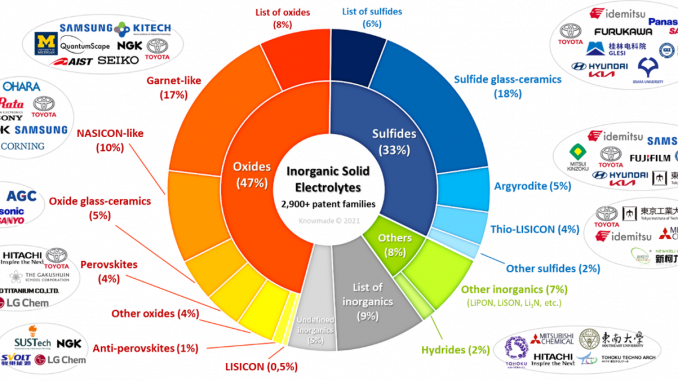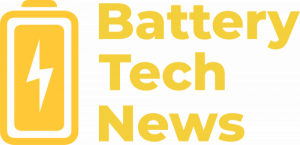
SOPHIA ANTIPOLIS, France – October 20, 2021.
Solid-state lithium-ion (Li-ion) batteries with inorganic solid electrolytes hold a key position in the booming developments to get safer Li-ion batteries with higher energy density and fast charging capability for electric and hybrid electric vehicles (EV/HEV). In a solid-state battery, the flammable liquid-electrolyte used in conventional Li-ion battery is replaced by a solid-state electrolyte, which results in greater safety and enhanced battery characteristics. Solid-state batteries can be classified into two categories: thin-film solid-state batteries with a small-energy capacity, already commercially available and aimed at applications in consumer electronics, and “bulk” solid-state batteries with large-energy capacity for EV/HEVs.
The thin-film technology approach proven for thin-film solid-state batteries is not directly applicable for bulk-type solid-state batteries. New processes and materials therefore have to be developed to get bulk solid-state batteries up to market requirements in terms of performance, stability and cost. There are currently three main axes for development to enhance bulk solid-state battery performance: improve solid electrolyte performances; improve the electrode/electrolyte interface; and develop material/cell assembly manufacturing processes compatible with industrial production.
Many companies have recently presented solid-state battery prototypes and announced their commercialization and integration in electric vehicles by 2025. However, many questions remain: which solid electrolyte has the most promising performance? What are the most recent technological developments? Who has the best position across the supply chain?
In this context, Knowmade is releasing a new patent landscape report related to solid-state Li-ion batteries with inorganic solid electrolytes covering the whole value chain from electrolyte materials to electrodes and battery cells. “Where other see patents, we see answers,” says Fleur Thissandier, PhD, Technology and Patent Analyst Batteries & Materials at Knowmade. “Patent landscape analysis is the perfect complement to market research, to fully comprehend the competitive landscape and technology roadmap, keep abreast of cutting-edge technology developments, anticipate future technology adoption, and understand the different competitors’ strategies. This kind of patent landscape report reveals the companies, technical solutions and strategies not identified through standard market analysis”, affirms Fleur Thissandier.
Knowmade’s analysts have selected and analyzed more than 14,400 patent filings grouped into 7,300+ patent families (inventions) related to inorganic-electrolyte-based solid-state lithium-ion batteries. This report reveals the main intellectual property (IP) trends, key patented technologies, recent development trends, key IP players and newcomers, their strategies regarding inorganic solid electrolyte materials, and their IP strategies and strengths by supply chain segment and inorganic electrolyte material.

Figure 1: Main patent assignees in the inorganic-electrolyte-based solid-state Li-ion batteries patent landscape.
We have identified more than 1,000 different entities that have filed patent applications related to inorganic-electrolyte-based solid-state Li-ion batteries. The report provides a clear overview of the most active patent assignees as well as a presentation of newcomers to the patent landscape. The inorganic-electrolyte-based solid-state Li-ion batteries patent landscape is quantitatively dominated by Japanese companies from all the value chain, Toyota being by far the most important patent assignees. Numerous Chinese companies have entered the IP landscape since 2016 such as QingTao Energy, SVOLT, COSMX, CATL, Zhejiang Funlithium New Energy (subsidiary of Ganfeng Lithium), Tianmu Energy Anode Material, New Keli Chemical, Lishen, Seres/SF Motors (subsidiary of Sokon), Baochuang/Bootory (R&D base of Baoneng Group), BOE Technology, China Lithium Battery Technology (CALB), SAIC Motor, RUISAIDE Energy Technology, WeLion New Energy, etc. The other noteworthy IP newcomers are American Solid Power, Storedot, Blue Current and IBM, the Japanese Showa Denko, JX Holdings, Taiheiyo Cement, SOKEN and Power IV, and the European Volkswagen, Renault and Vitesco Technologies.
Furthermore, patent segmentation reveals the IP position of patent assignees by supply chain segment (electrolyte materials, electrodes, battery cells) through a detailed analysis of their patent portfolios. We also provide insights into the key players’ patented technologies, their IP strategy, and their ability to limit other firms’ patenting activity and/or freedom-to-operate. The benchmarking of patent assignees is evaluated by supply chain segment, on the basis of their IP portfolio size, prior-art contribution, geographical coverage of the IP portfolio, and enforceability of their patents. A special focus is placed on the main IP collaborations (co-filings, license agreements, transfer of IP rights) related to solid-state Li-ion batteries with inorganic solid electrolytes.

Figure 2: Distribution of inorganic electrolyte materials claimed in patents related to solid-state Li-ion batteries and respective main patent assignees.
All patents selected for this study have been categorized by supply chain segment (electrolyte material, electrode, battery cell), electrolyte type (inorganic/polymer, inorganic) and inorganic electrolyte material (argyrodite, Thio-LISICON, sulfide glass ceramic, oxide glass ceramic, perovskite, anti-perovskite, LISICON, garnet, NASICON, hydride). For each supply chain segment, this report includes a time-evolution of patent applications, main and key patent assignees, newcomers, and a description of key and recently patented technologies. An understanding of the current technical challenges addressed in the patents is also presented.
The report provides a detailed analysis of a selection of key players: Toyota, Samsung, LG Chem, Panasonic/Sanyo, Idemitsu Kosan, Fujifilm, Bosch/SEEO, Murata/Sony, Hyundai/Kia, QuantumScape, QingTao Energy Development, SVOLT, and OHARA. For each player, we summarize their IP portfolio, highlight their strengths and weaknesses by segment, identify their key patents and provide information about their recent IP developments.

Figure 3: QuantumScape’s patent portfolio summary for inorganic-electrolyte-based solid-state Li-ion batteries.
This solid-state Li-ion batteries patent landscape report is accompanied by a valuable Excel database with the 7,300+ patent families (inventions) analyzed in this study. This useful patent database allows for multi-criteria searches and includes patent publication numbers, hyperlinks to an updated online database (original documents, legal status, etc.), priority date, title, abstract, patent assignees, patent’s current legal status, and segments (electrolyte materials, electrodes, battery cells, inorganic, inorganic/polymer, sulfide glass ceramics, Thio-LISICON, argyrodite, oxide glass ceramics, NASICON, perovskite, garnet, anti-perovskite, hydride, etc.).
All year long, Knowmade’s team investigate patenting activities related to batteries to get a deep understanding of the technology and intellectual property evolution, and their potential business impact. This solid-state Li-ion batteries report is part of a collection of IP reports and IP monitors including Solid Electrolytes for Li-ion Solid-State Batteries and Solid-State Batteries Patent Monitor.
Press contact
contact@knowmade.fr
Le Drakkar, 2405 route des Dolines, 06560 Valbonne Sophia Antipolis, France
About the author
Fleur Thissandier, PhD, Fleur works for Knowmade in the field of Materials Chemistry and Energy storage. She holds a PhD in Materials Chemistry and Electrochemistry from CEA/INAC, (Grenoble, France). She also holds a Chemistry Engineering Degree from the Superior National School of Chemistry (ENSCM Montpellier, France). Fleur previously worked in battery industry as R&D Engineer.
Contact: fleur.thissandier@knowmade.fr
About Knowmade
Knowmade is a Technology Intelligence and IP Strategy consulting company specialized in analysis of patents and scientific information. The company helps innovative companies and R&D organizations to understand their competitive landscape, follow technology trends, and find out opportunities and threats in terms of technology and patents.
Knowmade’s analysts combine their strong technology expertise and in-depth knowledge of patents with powerful analytics tools and methodologies to turn patents and scientific information into business-oriented report for decision makers working in R&D, Innovation Strategy, Intellectual Property, and Marketing. Our experts provide prior art search, patent landscape analysis, scientific literature analysis, patent valuation, IP due diligence and freedom-to-operate analysis. In parallel the company proposes litigation/licensing support, technology scouting and IP/technology watch service.
Knowmade has a solid expertise in Compound Semiconductors, Power Electronics, Batteries, RF Technologies & Wireless Communications, Solid-State Lighting & Display, Photonics, Memories, MEMS & Solid-State Sensors/Actuators, Semiconductor Manufacturing, Packaging & Assembly, Medical Devices, Medical Imaging, Microfluidics, Biotechnology, Pharmaceutics, and Agri-Food.
